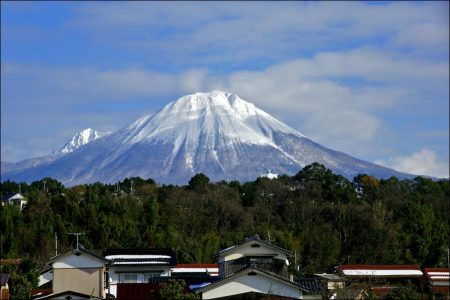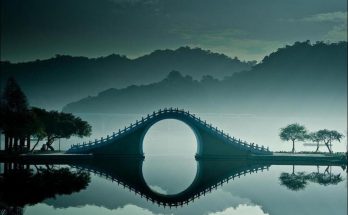Daisen literally means “great mountain.” Though its height is only 5,653 feet, it is the highest mountain in Chugoku district, on the shore of the Japan Sea. It is the Fuji of Japan’s “back.” The people of provinces round about Daisen look upon it, talk about it, ascend it, and worship it as much as the people on the “front” of Japan do Mount Fuji.
It lies somewhat away from the beaten track of the tourist, 216 miles north-west of Osaka by rail. It is none the less popular with the inhabitants of Hoki and Izumo, or prefectures of Shimane and Tottori, and their vicinity. The proposed National Park with Daisen as its center of attraction has been chosen, doubtless with an eye to the fact that it symbolizes the sea and mountain scenery on the Japan Seaboard.
Unlike Mount Fuji, Daisen has two faces, one, as viewed from the west, or Izumo, beautifully resembling the Suruga cone; the other, seen from the northern or southern side, is full of rugged, steep, rocky crags, which are grand, even majestic, but not symmetrical. Like Mount Fuji, it commands the veneration of people, far and wide. Daisenji Temple, half-way up the mountain (2,300 ft. from sea level), founded in 718, was a center of strong Buddhist influence of the Tendai Sect, once commanding more than two hundred temples and monasteries of this sacred mountain.
At one time, notably during the 14th century, Daisen was called the Hieisan of the Chūgoku district. Its turbulent and warlike monks instilled fear into the surrounding feudatories. It is said that the notorious priests of Daisen kept the doors of their monasteries hospitably open to outlaws, from whatever feudal territory, who sought shelter and protection under them, and these added greatly to the physical prowess and the political power of Daisen. The whole of Mount Daisen belonged to the Daisenji Temple, of course. A part of this temple, more than ten centuries old, is under Government protection, and the eleven-faced bronze Kwannon and 4 other Buddhist images kept there, are “national treasures.”
Judged for its beauty, its admirers acclaim Daisen to be the best in Japan. A writer describing the surpassing views, as seen from the top of Daisen, says: “To the north the vast expanse of the Sea of Japan embracing the Oki islands in its bosom lies before one; to the west, the province of Izumo with Lake Shinji and Shimane Peninsula as its scenic center; to the east the provinces of Hōki and Mimasaka, and Shikoku across the Chūgoku mountains and the Inland Sea. In summer the mountain attracts crowds of pilgrims and student mountaineers, and in the cold season the slopes afford good skiing.”
The proposed Daisen Park, 44,835 acres, includes, with Mt. Daisen as center, a host of surrounding mountains with their wide skirts, on the north, sloping to the water’s edge. It is the smallest after Unzen as a National Park, but the vastness of its wooded slopes is unique. The panorama of the surrounding landscape with the Oki-no-shima–“islands in the offing”–is enchanting beyond words.
These isles of Oki — inhabited by 35,000 people -mostly fishermen — are famous for their legendary and historical associations. Thither more than one hapless Emperor was exiled by disloyal military regents, and one of them–Godaigo Tenno–effected his escape in 1332 to Hōki, the land opposite, by concealing himself underneath the planks of a fisherman’s junk. He was hospitably treated by Nawa Nagatoshi at Senjōsen (2,230 feet), a spot commemorated for that reason.
Despite the vast number of pilgrims yearly attracted to the mountain, Daisen has somehow managed to keep itself undefiled from the threatened spoliation of vandals, and from garish attempts at artificial adornment. From the foot of the mountain to the Daisenji Temple is an easy climb, done by vehicular traffic, but from there to the top is hard work, and it takes nearly 3 hours to do the distance of a mile and a half only, but through a remarkable forest of beeches and “kyaraboku” — a species of yew trees. The top is crowned with one of the most marvelous panoramas the eye could ever hope to see. But you will see no crater, as Daisen is an extinct volcano, though its vicinity is not lacking in good hot springs.
Another feature of Daisen is that, unlike Fuji, which stands isolated, it forms a link in the long chain of mountains. This chain reminds one of the Swiss Alps. The whole chain is rich in alpine plants, which has earned for it the popular nickname of “Chūgoku Alps” — an increasingly popular skiing resort in winter.
Views: 234



